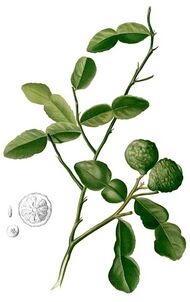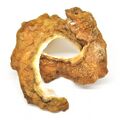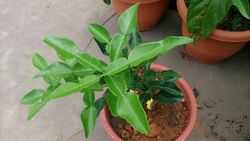Biology:Kaffir lime
| Kaffir lime | |
|---|---|
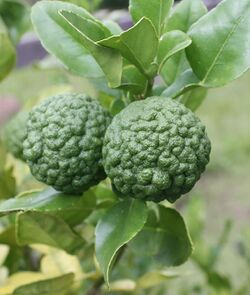
| |
| Fruit on tree | |
| Scientific classification | |
| Kingdom: | Plantae |
| Clade: | Tracheophytes |
| Clade: | Angiosperms |
| Clade: | Eudicots |
| Clade: | Rosids |
| Order: | Sapindales |
| Family: | Rutaceae |
| Genus: | Citrus |
| Species: | C. hystrix
|
| Binomial name | |
| Citrus hystrix | |
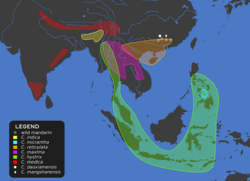
| |
| Map of inferred original wild ranges of the main Citrus cultivars, with C. hystrix in pale green[2] | |
| Synonyms[3] | |
| |
Citrus hystrix, called the kaffir lime or makrut lime,[4] (US: /ˈmækrət/, UK: /məkˈruːt/)[5] is a citrus fruit native to tropical Southeast Asia.[6][7]
Its fruit and leaves are used in Southeast Asian cuisine, and its essential oil is used in perfumery.[8] Its rind and crushed leaves emit an intense citrus fragrance.
Names
"Kaffir" is thought to ultimately derive from the Arabic kafir, meaning infidel, though the mechanism by which it came to be applied to the lime is uncertain. Following the takeover of the Swahili coast, Muslims used the term to refer to the non-Muslim indigenous Africans, who were increasingly abducted for the Indian Ocean slave trade, which reached a height in the fifteenth and sixteenth century.[citation needed]
The most likely etymology is through the Kaffirs, an ethnic group in Sri Lanka partly descended from enslaved Bantu.[9] The earliest known reference, under the alternative spelling "caffre" is in the 1888 book The Cultivated Oranges, Lemons Etc. of India and Ceylon by Emanuel Bonavia, who notes, "The plantation coolies also smear it over their feet and legs, to keep off land leeches; and therefore in Ceylon [Sri Lanka] it has also got the name of Kudalu dchi, or Leech Lime. Europeans call it Caffre Lime."[9][10] Similarly, H.F. MacMillan's 1910 book A Handbook of Tropical Gardening and Planting notes, "The 'Kaffir Lime' in Ceylon."[9][11]
Another proposed etymology is directly by Indian Muslims of the imported fruit from the non-Muslim lands to the east to "convey otherness and exotic provenance."[9] Claims that the name of the fruit derives directly from the South Africa n ethnic slur "kaffir" (see "South Africa" below) are not well supported.[9]
C. hystrix is known by various names in its native areas:
- jêruk purut in Javanese and limau purut in Malay (respectively into Indonesian and Malaysian) both meaning "warty/rough-skinned lime" due to the fruit's bumpy texture.[12][13]
- Script error: The function "transl" does not exist. (箭叶橙 "arrow-leaf lime") in Chinese.
- kabuyaw or kulubot in the Philippines.[14] The city of Cabuyao in Laguna is named after the fruit.[14]
- Kolumichai, கொலுமிச்சை in Kongu Tamil[15]
- Script error: The function "transl" does not exist. or Script error: The function "transl" does not exist. (มะกรูด, /máʔ.krùːt/) in Thailand (a name also used for the bergamot orange).
- Script error: The function "transl" does not exist. (ໝາກຂີ້ຫູດ, /ma᷆ːk.kʰi᷆ː.hu᷆ːt/) in Laos.
- trúc or chanh sác in Vietnam.[6][16]
- combava in Réunion Island
The micrantha, a similar citrus fruit native to the Philippines that is ancestral to several hybrid limes, such as the Key lime and Persian lime, may represent the same species as C. hystrix, but the genomic characterization of the kaffir lime has not been performed in sufficient detail to allow a definitive conclusion.[17]
South Africa
In South Africa, the Arabic kafir was adopted by White colonialists as "kaffir,"[9] an ethnic slur for black African people.[18] Consequently, some authors favour switching from "kaffir lime" to "makrut lime," a less well-known name, while in South Africa, it is usually referred to as "Thai lime."[19][20][21]
Description
C. hystrix is a thorny bush, 2 to 11 metres (6 to 35 ft) tall, with aromatic and distinctively shaped "double" leaves.[22][23] These hourglass-shaped leaves comprise the leaf blade plus a flattened, leaf-like stalk (or petiole). The fruit is rough and green and ripens to yellow; it is distinguished by its bumpy exterior and small size, approximately 4 cm (2 in) wide.[23]
History
Pierre Sonnerat (1748–1814) collected specimens of it in 1771-72, and it appears in Lamarck's Encyclopédie Méthodique (1796).[24][25]
Makrut lime appears in texts under the name of kaffir lime in 1868, in Ceylon, where rubbing the juice onto legs and socks prevents leech bites.[26] This could be a possible origin of the name leech lime.
Uses
Culinary
C. hystrix leaves are used in Southeast Asian cuisines such as Indonesian, Laotian, Cambodian, and Thai.[citation needed] The leaves are the most frequently used part of the plant, fresh, dried, or frozen. The leaves are widely used in Thai cuisine[27][28] (for dishes such as tom yum) and Cambodian cuisine (for the base paste "krueng").[29] The leaves are used in Vietnamese cuisine to add fragrance to chicken dishes and to decrease the pungent odor when steaming snails. Also, in Vietnamese villages that harvest silkworms, the silkworms in the pupa stage are stir fried with the kaffir lime leaves.[30] The leaves are used in Indonesian cuisine (especially Balinese cuisine and Javanese cuisine) for foods such as soto ayam and are used along with Indonesian bay leaf for chicken and fish. They are also found in Malaysian and Burmese cuisines.[31]
The rind (peel) is commonly used in Lao and Thai curry paste, adding an aromatic, astringent flavor.[27] The zest of the fruit, referred to as combava,[citation needed] is used in creole cuisine to impart flavor in infused rums and rougails in Mauritius, Réunion, and Madagascar .[32] In Cambodia, the entire fruit is crystallized/candied for eating.[33]
Medicinal
The juice and rinds of the peel are used in traditional medicine in some Asian countries; the fruit's juice is often used in shampoo and is believed to kill head lice.[23]
Other uses
The juice is used as a cleanser for clothing and hair in Thailand[28] and occasionally in Cambodia. Lustral water mixed with slices of the fruit is used in religious ceremonies in Cambodia.
Makrut lime oil is used as raw material in many fields, including pharmaceutical, agronomic, food, sanitary, cosmetic, and perfume industries. It is also used extensively in aromatherapy and as an essential ingredient in various cosmetic and beauty products.[34]
Striped snakehead fish stuffed with C. hystrix and lemongrass in preparation for steaming
Cultivation
C. hystrix is grown worldwide in suitable climates as a garden shrub for home fruit production. It is well suited to container gardens and for large garden pots on patios, terraces, and in conservatories.
Main constituents
The compound responsible for the characteristic aroma was identified as (–)-(S)-citronellal, which is contained in the leaf oil up to 80 percent; minor components include citronellol (10 percent), nerol and limonene.
From a stereochemical point of view, it is remarkable that makrut lime leaves contain only the (S) stereoisomer of citronellal, whereas its enantiomer, (+)-(R)-citronellal is found in both lemon balm and (to a lesser degree) lemon grass, (however, citronellal is only a trace component in the latter's essential oil).
Makrut lime fruit peel contains an essential oil comparable to lime fruit peel oil; its main components are limonene and β-pinene.[8][35]
Toxicity
C. hystrix contains significant quantities of furanocoumarins, in both the peel and the pulp.[36] Furanocoumarins are known to cause phytophotodermatitis,[37] a potentially severe skin inflammation. Cases of phytophotodermatitis induced by external use of C. hystrix have been reported.[38]
See also
- Biology:Citrus taxonomy – Botanical classification of the genus Citrus
References
- ↑ "TPL, treatment of Citrus hystrix DC.". The Plant List; Version 1. (published on the internet). Royal Botanic Gardens, Kew and the Missouri Botanical Garden. 2010. http://www.theplantlist.org/tpl/record/kew-2724129.
- ↑ Fuller, Dorian Q.; Castillo, Cristina; Kingwell-Banham, Eleanor; Qin, Ling; Weisskopf, Alison (2017). "Charred pomelo peel, historical linguistics and other tree crops: approaches to framing the historical context of early Citrus cultivation in East, South and Southeast Asia". in Zech-Matterne, Véronique; Fiorentino, Girolamo. AGRUMED: Archaeology and history of citrus fruit in the Mediterranean. Publications du Centre Jean Bérard. pp. 29–48. doi:10.4000/books.pcjb.2107. ISBN 9782918887775. https://books.openedition.org/pcjb/2173?lang=en.
- ↑ The Plant List: A Working List of All Plant Species, http://www.theplantlist.org/tpl1.1/record/kew-2724129, retrieved 3 October 2015
- ↑ D.J. Mabberley (1997), "A classification for edible Citrus (Rutaceae)", Telopea 7 (2): 167–172, doi:10.7751/telopea19971007
- ↑ {{citation | mode = cs1 | title = Kaffir lime | work = Germplasm Resources Information Network (GRIN) | url = | publisher = [[Organization:Agricultural Research ServAgricultural Research Service (ARS), United States Department of Agriculture (USDA) | access-date = December 7, 2014 }}
- ↑ 6.0 6.1 "Citrus hystrix". National Parks Singapore, Singapore Government. https://florafaunaweb.nparks.gov.sg/Special-Pages/plant-detail.aspx?id=3670.[|permanent dead link|dead link}}]
- ↑ "Citrus hystrix". Missouri Botanical Garden. http://www.missouribotanicalgarden.org/PlantFinder/PlantFinderDetails.aspx?taxonid=291778&isprofile=0&.
- ↑ 8.0 8.1 Ng, D.S.H.; Rose, L.C.; Suhaimi, H.; Mohamad, H.; Rozaini, M.Z.H.; Taib, M. (2011). "Preliminary evaluation on the antibacterial activities of Citrus hystrix oil emulsions stabilized by TWEEN 80 and SPAN 80". International Journal of Pharmacy and Pharmaceutical Sciences 3 (Suppl. 2). http://www.ijppsjournal.com/Vol3Suppl2/2007.pdf. Retrieved 2014-12-10.
- ↑ 9.0 9.1 9.2 9.3 9.4 9.5 Anderson, L. V. (3 July 2014). "Is the Name Kaffir Lime Racist? Why You May Want to Think Twice About Using That Term." (in en). https://slate.com/culture/2014/07/kaffir-lime-racist-murky-origins-suggest-a-racial-slur-might-be-responsible-for-the-fruits-name.html.
- ↑ Macmillan, Hugh Fraser (1910). A handbook of tropical gardening and planting with special reference to Ceylon. Colombo, Ceylon: H. W. Cave & Co.. p. 157. https://archive.org/details/cu31924001733793/page/n157/mode/2up.
- ↑ Wilkinson, Richard James (1932). "purut". purut. II. Mytilene: Salavopoulos & Kinderlis. p. 291. https://nla.gov.au/nla.obj-60272783/view?partId=nla.obj-436263050#page/n295/mode/1up/search/purut.
- ↑ pann (2019-04-07). "Apa itu purut?" (in id-ID). https://glosarium.org/arti-purut/.
- ↑ 14.0 14.1 (in en) CRC World Dictionary of Medicinal and Poisonous Plants: Common Names, Scientific Names, Eponyms, Synonyms, and Etymology. M-Q. CRC Press/Taylor & Francis. 2012-01-01. ISBN 9781439895702. https://books.google.com/books?id=IIp-mAEACAAJ.
- ↑ "Citrus hystrix DC. | Species" (in en). https://indiabiodiversity.org/species/show/225573.
- ↑ Katzer, Gernot. "Kaffir Lime (Citrus hystrix DC.)". http://gernot-katzers-spice-pages.com/engl/Citr_hys.html.
- ↑ Ollitrault, Patrick; Curk, Franck; Krueger, Robert (2020). "Citrus taxonomy". The Citrus Genus. Elsevier. pp. 57–81. doi:10.1016/B978-0-12-812163-4.00004-8. ISBN 9780128121634. https://books.google.com/books?id=2wo4swEACAAJ&pg=PA57.
- ↑ Vinje, Veronica (2014-06-23). "Saying "kaffir lime" is like saying the N-word before "lime"" (in en). https://www.straight.com/news/671106/veronica-vinje-saying-kaffir-lime-saying-n-word-lime.
- ↑ McKenna, Maryn (2014-07-18), "A Food Has a Historic, Objectionable Name. Should We Change It?", National Geographic, http://theplate.nationalgeographic.com/2014/07/18/a-food-has-an-historic-objectionable-name-should-we-change-it/, retrieved 12 December 2015
- ↑ Common lime name has racist history by Khalil Akhtar, CBC News, Jul 8, 2014
- ↑ "Kaf·fir also kaf·fir". American Heritage Dictionary. https://www.ahdictionary.com/word/search.html?id=K5002600.
- ↑ Kumar, Kuntal (1 January 2008). The Original Organics Cookbook: recipes for healthy living. TERI Press. p. 54. ISBN 978-81-7993-155-4. https://books.google.com/books?id=eG2zBAAAQBAJ&pg=PT54.
- ↑ 23.0 23.1 23.2 Staples, George; Kristiansen, Michael S. (1 January 1999). Ethnic Culinary Herbs: A Guide to Identification and Cultivation in Hawai'i. University of Hawaii Press. pp. 27–29. ISBN 978-0-8248-2094-7. https://books.google.com/books?id=jbsdYHEJiDIC&pg=PA27.
- ↑ D. J. MABBERLEY (2002). "Limau Hantu and Limau Purut. the Story of Lime-Leaves (Citrus hystrix DC, Rutaceae)?". Gardens' Bulletin Singapore 54: 185–197. https://www.nparks.gov.sg/sbg/research/publications/gardens-bulletin-singapore/-/media/sbg/gardens-bulletin/4-4-54-2-04-y2002-v54p2-gbs-pg-185.pdf. Retrieved 12 March 2022.
- ↑ Bonavia, Emanuel (1888–90). The cultivated oranges and lemons, etc. of India and Ceylon, with researches into their origin and the derivation of their names, and other useful information. With an atlas of illustrations. London: W. H. Allen. p. 309. https://archive.org/details/cultivatedorange00bonarich/page/309/mode/2up?q=hystrix. Retrieved 31 May 2021.
- ↑ Henderson, John (capt. 78th Highlanders.) (1868). Skeet, Ch. J.. ed. The History of the Rebellion in Ceylon During Lord Torrington's Government: Affording a Comparison with Jamaica and Governor Eyre. University of Minnesota. p. 58. https://books.google.com/books?id=HAM3AQAAMAAJ&q=%22kaffir+lime%22&pg=PA58. Retrieved 31 May 2021.
- ↑ 27.0 27.1 Loha-unchit, Kasma. "Kaffir Lime –Magrood". http://www.thaifoodandtravel.com/ingredients/klime.html.
- ↑ 28.0 28.1 Sukphisit, Suthon (12 November 2017). "Clean up in kitchen with versatile fruit". Bangkok Post. https://www.bangkokpost.com/lifestyle/social-and-lifestyle/1359143/clean-up-in-kitchen-with-versatile-fruit.
- ↑ "What to Replace Kaffir Lime Leaves With" (in en-US). 2018-12-17. https://www.village-bakery.com/kaffir-lime-leaves-substitute/.
- ↑ "How Mountains Of Worm Cocoons Are Turned Into Expensive Silk In Vietnam | Big Business". https://www.youtube.com/watch?v=xBz40ZxKJBs.
- ↑ Wendy Hutton, Wendy; Cassio, Alberto (2003). Handy Pocket Guide to Asian Herbs & Spices. Singapore: Periplus Editions. p. 40. ISBN 978-0-7946-0190-4. https://books.google.com/books?id=T-Hh-ezDkVwC&q=kaffir+lime+limau+purut&pg=PA40.
- ↑ "Mauritian rum has a distinct character to it: Sweeter and smoother". The Economic Times. 2015-03-22. https://economictimes.indiatimes.com/industry/cons-products/liquor/mauritian-rum-has-a-distinct-character-to-it-sweeter-and-smoother/articleshow/46647281.cms.
- ↑ Dy Phon Pauline, 2000, Plants Used In Cambodia, printed by Imprimerie Olympic, Phnom Penh
- ↑ Suresh, Anuja; Velusamy, Sangeetha; Ayyasamy, Sudha; Rathinasamy, Menaha (2021). "Techniques for essential oil extraction from makrut lime and its application in health care products—A review". Flavour and Fragrance Journal 36: 5–21. doi:10.1002/ffj.3626. https://onlinelibrary.wiley.com/doi/epdf/10.1002/ffj.3626.
- ↑ Kasuan, Nurhani (2013). "Extraction of Citrus hystrix D.C. (Kaffir Lime) Essential Oil Using Automated Steam Distillation Process: Analysis of Volatile Compounds". Malaysian Journal of Analytical Sciences 17 (3): 359–369. http://www.ukm.my/mjas/v17_n3/Nurhani.pdf.
- ↑ Dugrand-Judek, Audray; Olry, Alexandre; Hehn, Alain; Costantino, Gilles; Ollitrault, Patrick; Froelicher, Yann; Bourgaud, Frédéric (November 2015). "The Distribution of Coumarins and Furanocoumarins in Citrus Species Closely Matches Citrus Phylogeny and Reflects the Organization of Biosynthetic Pathways". PLOS ONE 10 (11): e0142757. doi:10.1371/journal.pone.0142757. PMID 26558757. Bibcode: 2015PLoSO..1042757D.
- ↑ McGovern, Thomas W.; Barkley, Theodore M. (2000). "Botanical Dermatology". The Electronic Textbook of Dermatology (Internet Dermatology Society) 37 (5): Section Phytophotodermatitis. doi:10.1046/j.1365-4362.1998.00385.x. PMID 9620476. http://telemedicine.org/botanica/bot1.htm. Retrieved November 29, 2018.
- ↑ Koh, D.; Ong, C. N. (April 1999). "Phytophotodermatitis due to the application of Citrus hystrix as a folk remedy". Br J Dermatol 140 (4): 737–738. doi:10.1046/j.1365-2133.1999.02782.x. PMID 10233333.
Wikidata ☰ Q465934 entry
 |
